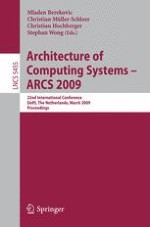2009 | Buch
Architecture of Computing Systems – ARCS 2009
22nd International Conference, Delft, The Netherlands, March 10-13, 2009. Proceedings
herausgegeben von: Mladen Berekovic, Christian Müller-Schloer, Christian Hochberger, Stephan Wong
Verlag: Springer Berlin Heidelberg
Buchreihe : Lecture Notes in Computer Science
